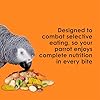When it comes to choosing a pet bird, many people are drawn to parakeets. Two popular species of parakeets are the Alexandrine and the Indian Ringneck.
While they may appear similar, they have some distinct differences that set them apart.
In this article, I will explore the physical, behavioral, and care differences between Alexandrine and Ringneck parakeets to help you decide which bird is best for you.
Table of Contents
Physical Differences
Size and Weight
One of the most noticeable differences between the two species is their size. Alexandrine parakeets are larger, measuring around 22 to 24 inches in length, while Indian Ringnecks are slightly smaller, at around 16 inches long. Weight-wise, Alexandrines tend to weigh between 250 and 300 grams, whereas Ringnecks average around 120 to 160 grams.
Beak and Head
Another difference lies in the beak and head shape. Alexandrines have a broader head with a more powerful beak, making them capable of cracking open larger seeds and nuts. On the other hand, Indian Ringnecks have smaller heads with a slender beak, suitable for eating smaller seeds.
Feather Colors
While both species come in a range of colors, there are some differences in their natural coloration. Alexandrine parakeets have green bodies with blue feathers on their tail and neck and maroon patches on their wings.
Male Alexandrines also have a black stripe on their neck, which is absent in females. Indian Ringnecks have a more uniform green color, with a black and rose-colored ring around the neck in males, and a faint shadow of the ring in females.
Behavioral Differences
Social Behavior
Alexandrine parakeets are generally more social and enjoy interacting with their owners. They are also more likely to bond with multiple people in the household. In contrast, Indian Ringnecks can be more independent and may form a strong bond with a single person.
Vocalizations
Both species are known for their ability to mimic human speech, but their vocalizations differ. Alexandrines have a deeper, more raspy voice, while Indian Ringnecks have a higher-pitched, clearer voice. Both birds can be quite vocal, and their calls can carry quite a distance.
Trainability and Intelligence
While both species are intelligent and can be trained, Alexandrines are often considered more trainable due to their social nature. However, with patience and consistent training, Indian Ringnecks can also learn a variety of tricks and commands.
Lifespan and Health
Lifespan
In terms of lifespan, both Alexandrine and Indian Ringneck parakeets can live for 20 to 30 years when provided with proper care and nutrition. However, Alexandrine parakeets have been known to live slightly longer, up to 35 years in some cases.
Matiniy 2 Pcs Pirate Parrot on Shoulder Life Sized Artificial Parrot Toy for Costume Dress-up Accessory for Halloween Party(Multicolor)
$14.99 (as of 26/12/2025 08:36 GMT +03:00 - More infoProduct prices and availability are accurate as of the date/time indicated and are subject to change. Any price and availability information displayed on [relevant Amazon Site(s), as applicable] at the time of purchase will apply to the purchase of this product.)Bird Toys, Parrot Toys for Large Birds,Natural Corn cob and Loofah Slices Bird chew Toys for African Grey Parrots, Macaws, Cockatoos, Amazon Parrot and other Small and Medium-Sized Parrot (Colorful)
$12.97 ($12.97 / count) (as of 26/12/2025 11:49 GMT +03:00 - More infoProduct prices and availability are accurate as of the date/time indicated and are subject to change. Any price and availability information displayed on [relevant Amazon Site(s), as applicable] at the time of purchase will apply to the purchase of this product.)Kaytee Fiesta Parrot Food, Nutritious and Fun Blend, Supports Skin, Feather, Digestion, Brain and Heart Health, 4.5 pounds
16% OffHealth Concerns
Both species are generally healthy, but they can be prone to some health issues. Alexandrine parakeets are susceptible to obesity, while Indian Ringnecks may develop respiratory infections and feather-plucking problems. Regular veterinary checkups and a well-balanced diet can help keep these issues at bay.
Housing and Care
Cage Requirements
Due to their size difference, Alexandrine parakeets require a larger cage compared to Indian Ringnecks. For Alexandrines, a cage with dimensions of at least 36x24x48 inches is recommended, while for Ringnecks, a cage measuring a minimum of 24x24x36 inches is suitable. Both species need ample space for toys, perches, and exercise.
Diet and Nutrition
A balanced diet is essential for both species. A good-quality seed or pellet mix, supplemented with fresh fruits and vegetables, is ideal. Alexandrines may need larger seeds or nuts due to their stronger beak. Both species require calcium sources, like cuttlebone, to ensure healthy beak and bone development.
Choosing the Right Bird for You
When deciding between an Alexandrine and an Indian Ringneck, consider your lifestyle and preferences. If you desire a more social and interactive bird, an Alexandrine may be a better fit.
If you prefer a more independent companion, an Indian Ringneck might be more suitable. Keep in mind the size of your living space and the time you can dedicate to care, training, and socialization.
Conclusion
Alexandrine and Indian Ringneck parakeets are both beautiful and intelligent birds, but they have distinct differences in size, appearance, and behavior. By understanding these differences, you can make an informed decision about which bird is the right fit for your family and lifestyle.
FAQs
1. Are Alexandrine and Indian Ringneck parakeets good pets for first-time bird owners?
Both species can be suitable for first-time bird owners, provided that the owner is willing to invest time in learning about their care and socialization needs. However, Alexandrines may be more forgiving due to their social nature.
2. Can Alexandrine and Indian Ringneck parakeets talk?
Yes, both species are known for their ability to mimic human speech. They can learn a variety of words and phrases with proper training and socialization.
3. Are Alexandrine and Indian Ringneck parakeets loud?
Both species can be quite vocal, and their calls can carry a considerable distance. If noise is a concern, it is essential to consider this before choosing either of these parakeets as pets.
4. Can Alexandrine and Indian Ringneck parakeets be housed together?
It is generally not recommended to house different parrot species together, as they may have different social and care needs. Additionally, there is a risk of aggression or injury between the two species.
5. What is the average cost of an Alexandrine or Indian Ringneck parakeet?
The cost of an Alexandrine parakeet can range from $300 to $600, while Indian Ringneck parakeets can cost between $200 and $500. Prices may vary depending on factors like age, color, and whether the bird is hand-tamed or not.
























